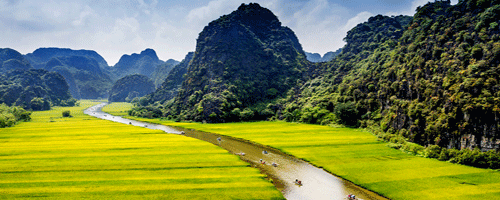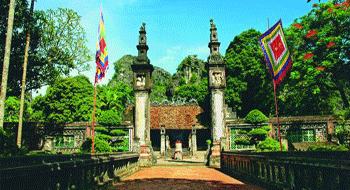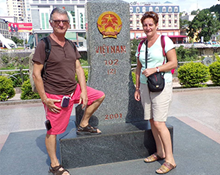- Home
- OUR ITINERARIES
- GUIDEBOOK
- VIETNAM HISTORY
- USEFUL INFORMATIONS
- BEFORE DEPARTURE
- VISIT HA LONG BAY BY SEAPLANE
- MOST BEAUTIFUL BEACHS IN VIETNAM
- GEOGRAPHY & CLIMATE IN VIETNAM
- VIETNAM CULTURE
- NIGHT IN HOMESTAY
- CRUISING IN VIETNAM
- ACCOMMODATION & ADVISES
- BEACH, SNORKELING & DIVING HOLIDAY
- TRAVEL WITH FAMILY
- GOLF
- DOMESTICS FLIGHTS
- OFF THE BEATEN TRACK TOUR
- SITES TO DISCOVER
- ABOUT US
- CUSTOMIZED TOUR
Halong Bay on land is a tourist destination comprising the natural and cultural heritage of the World classified by UNESCO in the province of Ninh Binh in the north of the country. Many monuments and landscapes have also been added by the Vietnamese government to the list of particularly important national heritages, such as the destination of Tam Coc - Bich Dong, the Bai Dinh pagoda, the ancient capital of Hoa Lu, the eco region. -spiritual of Trang An… belong to Terrestrial Halong Bay.
Halong Bay Terrestrial covers a very important marshy region with various rocky landscapes, limestone mountains, the ecosystem where the flora and fauna are very varied, lakes, rice fields in flooded land, and countless river routes offering to its visitors a special impression. Halong Bay Terrestre has beautiful caves to know such as: Thien Ha (Galaxy Cave), Thien Thanh (Blue Sky Cave), Tien (Fairy Cave), Vai Gioi (Cave of Prayers in Heaven), Thuy Cung ( Aquarium Cave), Phat (Buddha Cave), Tam Coc (Three Caves), Trang An Caves… and several valuable archaeological sites such as Hang Moi, Hang Boi, Hang Trong, Mai Oc…. To this can be added the ancient capital of Vietnam Hoa Lu from 938 to 1009, many vestiges of other historical dynasties of Vietnam such as: Dinh, Le, Ly, Tran…, the Vu Lam palace, the pagoda of Jade, the temples of Dinh Tien Hoang, Le Dai Hanh, Thai Vi…, without forgetting the magnificent ornithological reserves of the valley of Thung Nham, the valley of Thung Nang or the valley of the Sun…
Halong Terrestrial Bay, with the absolute consensus of the World Heritage Committee, was officially added to the World Heritage List in Doha on June 23, 2014. Especially the Terrestrial Halong Bay is the first World Heritage in Vietnam responding to the two important criteria of Nature and Culture both to be classified as the Natural and Cultural Heritage of Humanity. The Terrestrial Halong Bay in Vietnam also remains the only Heritage in South East Asia to benefit from this title.
Halong Bay Terrestrial - Geographical position:
Halong Terrestrial Bay is located 3 km south of the ancient capital of Hoa Lu, 7 km west of Ninh Binh city or 96 km south of Hanoi. The Central Trang an - Tam Coc Heritage Region has an area of over 6,172 hectares, belonging to the Specially Protected Region of the entire ancient capital of Hoa Lu - Trang An with an area of 12,252 ha.
Terrestrial Halong Bay and its titles:
Natural Heritage of the World:
Halong Bay Terrestrial, with its system of limestone mountains dating back about 250 million years and all orogenic activities, tectonics of geological history, erosion as well as climate change for long periods, preserves hundreds of valleys, caves, lakes and marshes which keep the most typical geological formation of the country. There are numerous ecosystems, flooded forests, limestone mountain forests and historical monuments related to the history of the ancient capital of Hoa Lu dating back to the 10th century.
With the outstanding values of natural landscape, tectonic activities of geology, history and culture, UNESCO classified Terrestrial Halong Bay as Natural Heritage of Humanity in 2014.
Halong Bay Terrestrial is one of the places with the most beautiful karst landscapes in the world. This landscape is covered with towering sugar loaves up to 200 meters high, surrounded by mountains and rivers linked together by a system of canals carved out by erosion over time. The limestone mountains, the river, the forest and the sky give shape here to a living, harmonious and charming natural world. This is a very special place where culture comes in touch with the greatness of the natural world. This region has a very beautiful nature with limestone mountains, mysterious caves, quiet rivers, sacred relics and rich and rare flora and fauna.
Halong Bay Terrestrial is famous for karst dotted with a series of permanent streams and seasonally flooded valleys. There are many beautiful caves in the area like Thien Ha (Galaxy Cave), Thien Thanh (Blue Sky Cave), Tien (Fairy Cave), Vai Gioi (Cave of Prayers in Heaven), Thuy Cung (Cave of Heaven) 'Aquarium), Phat (Buddha Cave), Tam Coc (Three Caves), Trang An Caves ...
Halong Bay Terrestrial bears witness to the last stage in the karstic evolution of the humid tropical climate. Geological and geomorphological diversity results from permanent geological activity over hundreds of millions of years from Triassic to Quaternary. During this time the huge karst massifs collapsed. These major geological events created pristine and charming mountains, sedimentary valleys, rivers, caves at Halong Bay Terrestrial.
World Cultural Heritage:
Halong Bay Terrestrial retains remarkable value with regard to the criteria of a world cultural heritage. Trang An testifies to the perfect adaptation of man to changes in the climate, geography and historical environment of the Earth. It is here that we prove in a fascinating way how man is able to adapt to nature and to these climatic, geological changes of the earth lasting at least 30,000 years.
More than 30 prehistoric archaeological sites have been discovered there. Research results show how prehistoric humans adapted to these major changes. For at least 23,000 years, certain civilizations have developed successively in this home, from the Paleolithic through the Neolithic, to the Iron and Bronze Age. In special conditions where only limestone is available, prehistoric humans already knew how to use it as working tools at least 3000 years ago in Halong Terrestrial Bay.
The continued use of ceramics from early history at Halong Terrestrial Bay shows that a ceramics center, unlike many other centers in Vietnam, has existed here. PhD student Masanari Nishimura, a Japanese, through archaeological studies, confirmed: 5000-6000 years ago there was a major earthquake here and the prehistoric Vietnamese were able to adapt to several transformations of nature to to develop to this day and to retain cultural value at Halong Terrestrial Bay.
Until the 10th century, in the Hoa Lu Valley, the inhabitants of Terrestrial Halong Bay established a prosperous civilization in perfect harmony with nature and climatic conditions. The national hero Dinh Bo Linh, after reuniting the 12 factious governors, had ordered to build his reign there by building protective enclosures around the capital while connecting sugar loaves. The Vietnamese feudal court was thus born, independent and prosperous, giving shape to a period of prosperity and sovereignty of the country with the succession of several dynasties: Dinh, The anterior, Ly posterior with many historical landmarks / Reunification of the kingdom, struggle against the Chinese several times then the Chams and the construction of the capital in Hanoi.
In the 13th century, the Tran dynasty again chose to build Vu Lam Fortress at Terrestrial Halong Bay as a military base to prepare the forces contributing largely to the final victory against the Mongols. It is also the place where the Tran kings became monks to develop Buddhism in Vietnam.
The ancient capital of Hoa Lu today keeps a great historical, cultural and tourist value with many monuments such as the temple worshiping King Dinh Tien Hoang, the temple worshiping King Le Dai Hanh, temple worshiping Princess Kim Phat, Nhat Tru Pagoda, Kim Ngan Pagoda, Duyen Ninh Pagoda, Yen Trach Temple, Ba Ngo Pagoda, Tran Temple, Bai Dinh Pagoda, Hoa Lu Cave, Cave de Thien Ton ... Thanks to these values, UNESCO has recognized the Terrestrial Halong Bay as the Cultural Heritage of Humanity.
Informations
GUIDEBOOK
AVANT LE DEPARTAdd: Quat Dong, Thuong Tin, Ha Noi INTERNATIONAL TOURISM LICENSE
Tel / whatsapp : +84 976 255 369 No : 01-1157/2018/ TCDL-LHQT
ZEN VIETNAM TRAVEL, A Branch of Thuong Tin Tourist
© Copyright from ZEN VIETNAM TRAVEL












